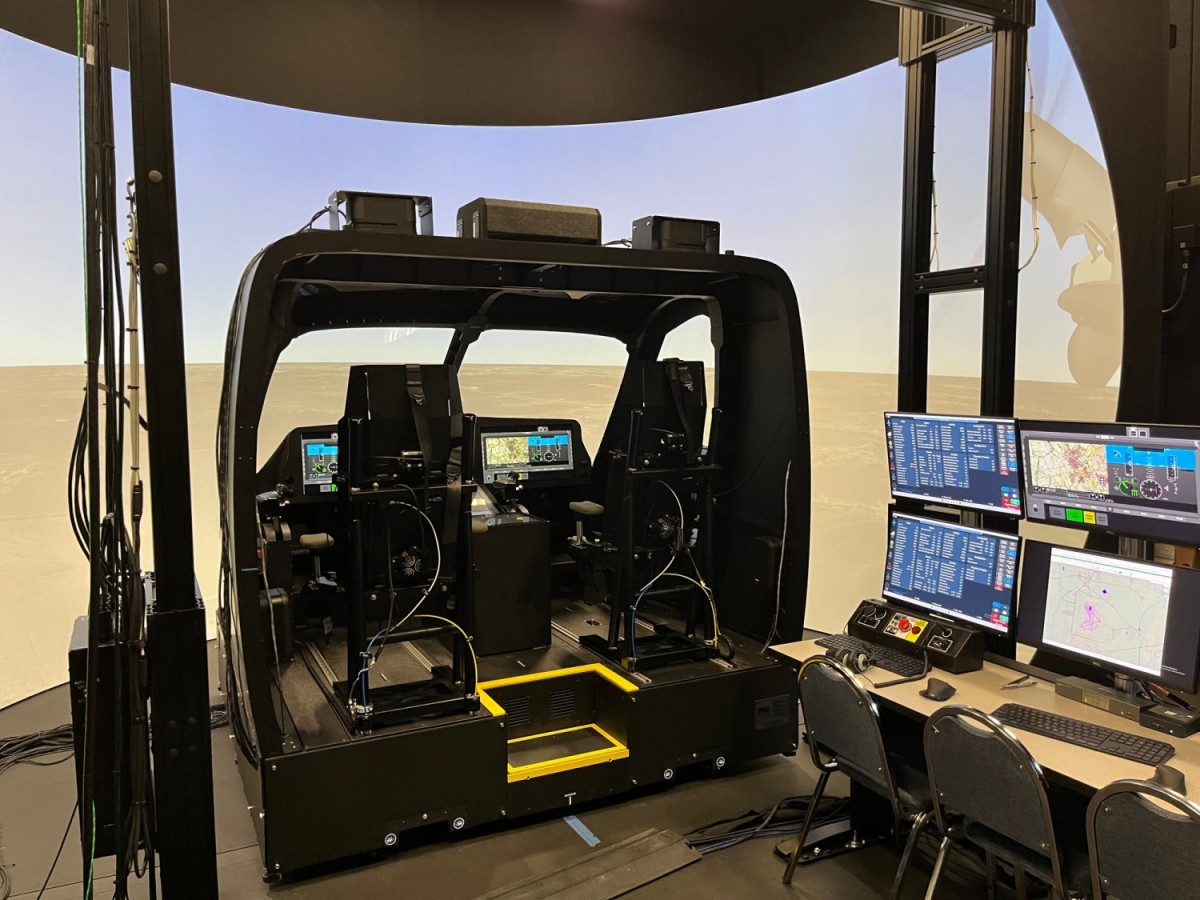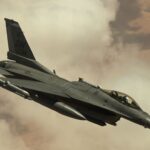Bell Textron has handed the first MV-75 virtual prototype to the U.S. Army, marking a concrete step in the Future Long-Range Assault Aircraft program. Defense officials confirm the hand-off took place at Redstone Arsenal, Alabama, on 24 June, only eighteen months after the contract’s Milestone B decision. The digital twin now sits with the Army’s aviation project office, where engineers will run mission rehearsals and early software tests.
According to industry sources, the virtual prototype mirrors the hardware layout of the future tiltrotor. Screens, controls, data buses, and flight-control laws all match what will fly in 2027. This approach lets the service stress-test avionics and crew-station logic without waiting for metal to cut. Army engineers can patch code in hours instead of weeks, then watch results on a full-motion platform. Similar to the AE 1107C engine powering the V-22 fleet, which recently hit the 500-hour mark demonstrating reliability.
MV-75 FLRAA Military Aviation Development Advances with Digital Twin Prototype
Our analysis shows the service bought two virtual prototypes under the same line item that funds the physical demonstrators. The second unit will arrive at the Aviation Center of Excellence later this month. Planners intend to split duties: one cockpit stays at Redstone for system integration; the other moves to Fort Novosel for tactics development. That separation reduces scheduling friction and speeds feedback to Bell’s design team.
Key functions of the virtual prototype:
- Flight-control law validation under high-load corner cases
- Crew-station ergonomics checks with line pilots
- Rapid software iteration backed by model-based systems engineering
- Early maintenance diagnostics against the digital twin
- Exportable data packages for safety certification
Field-grade pilots from the 101st Airborne will be the first users. They plan to fly scripted assault profiles, evaluate control harmony, and flag workload spikes. The test set includes brown-out landings, confined-area approaches, and cruise segments at 250 kt. Defense officials add that each session feeds objective data into the Joint Simulation Environment, tightening the loop between lab, simulator, and future flight test.
Future Long-Range Assault Aircraft Program Leverages Agile Software and Maintenance Innovations
Bell’s engineers built the cockpit on a common-core computer architecture first shown in the V-280 demonstrator. Wiring harnesses, processors, and displays remain agnostic to mission packages. Swapping a troop-lift configuration for a medevac kit takes under thirty minutes in software, letting mission-planners rehearse multiple roles. The practice also exposes growth paths for autonomy modules and optionally-piloted operations later in the decade.
Program managers highlight cost control. A virtual prototype burns no fuel and needs no flight-line crew, yet it reveals air-worthiness issues that could ground the real aircraft. Early discovery cuts rework budgets. Savings then roll into the physical prototype now scheduled for first lift in the second quarter of 2027. If the flight article meets performance targets – 430 km combat radius, 12-soldier cabin, and 305-kt dash – it should clear Milestone C in 2029 and reach first unit equipped in 2030.
Bell Textron’s MV-75 FLRAA Production and Sustainment Strategy for Modern Army Aviation
The Army plans to buy “at least 1,000” MV-75s, though officials caution that final quantities ride on inflation and force-structure reviews. Even the low-end figure will strain the rotorcraft industrial base. Bell has already expanded its Amarillo, Texas, assembly footprint by 20 percent and signed long-lead contracts for composite blades and gearbox castings. According to program insiders, the company aims to deliver the first production fuselage sections in late 2026, giving two years for line-flow validation.
Sustainment weighs heavily in the design. The digital twin funnels real-time strain and cycle counts into a predictive-maintenance algorithm. When the physical aircraft enters service, maintainers will compare live telemetry with the prototype’s baseline to forecast part swaps. The goal is to shift from interval-based to condition-based maintenance, freeing flight hours while cutting depot backlog. Logistics officers expect a 30 percent drop in unscheduled component removals once the system matures.
Training also changes. The virtual cockpit can upgrade to a Level-D simulator with minimal hardware tweaks. Army Aviation Center instructors will fit a high-resolution visual dome, motion base, and environmental cues such as rotor down-wash audio. That roadmap shortens certification cycles for new tactics. For example, medevac crews can practice high-hot hoist profiles inside climate-controlled bays rather than burning engine time at altitude. This follows the recent acceptance of the MV-75 virtual prototype by the Army, marking a major milestone in the program’s development.
Agile Software Development and Modular Systems Drive MV-75 FLRAA Innovation
Bell’s software team uses an agile sprint schedule locked to the Army’s own DevSecOps pipeline. Every four weeks, coders drop a build that testers load into the prototype. Faults log automatically, rank by severity, and feed back to developers in near real-time. This rhythm breaks the traditional waterfall model that hamstrung legacy rotorcraft upgrades. It also aligns with Congressional calls for modular open-systems architectures across Army platforms.
Risk reduction extends beyond software. Bell shipped a set of 3D-printed cabin mock-ups to infantry brigades last year. Soldiers crawled through troop seats, checked weapon arcs, and timed egress drills. Feedback pushed minor tweaks into the digital definition: seat pitch widened by two inches, tie-down rings moved aft, and a crew-chief window gained a sliding panel. Those edits now appear in the virtual prototype, proving the loop from field to factory stays alive.
Defense acquisition staff view the MV-75 effort as a bellwether for other aviation programs. If schedules hold, the Army will compress design-to-build time by almost forty percent versus UH-60A timelines. The service credits stable funding lines, early user touchpoints, and a digital thread that spans engineering, manufacturing, and sustainment. Lawmakers tracking the program hint that similar methods may guide the Future Attack Reconnaissance Aircraft and Improved Turbine Engine Program.
Bell leadership says the virtual prototype also benefits subcontractors. Small-business suppliers plug their digital models into the main environment and run tolerance studies before cutting chips. That visibility reduces first-article rejections and spreads workshare across at least eleven states. Advanced Manufacturing of Amarillo now produces composite skin panels with out-of-autoclave curing, while Delta Gear in Michigan machines the split-torque main gearbox. Both firms cite the MV-75 contract as a springboard for new hiring in 2025-26.
The Army will measure prototype success against five near-term milestones:
- Complete software build 4.0 with mission-planning plug-ins by December 2025
- Finalize air-worthiness release criteria for ground test in March 2026
- Achieve first power-on for the physical aircraft in July 2026
- Conduct low-speed taxi tests in February 2027
- Fly first lift in May 2027
Each step feeds gate reviews that decide production-rate ramp-ups. Should the program slip, procurement dollars could shift to service-life extensions on current Black Hawks. Program managers insist the digital baseline gives them confidence to hold schedule, yet they acknowledge engine supply-chain health remains a watch item.
MV-75 FLRAA Production Funding and Joint Service Variant Development
Congress funded the MV-75 line through a mix of base and Overseas Contingency Operations accounts, shielding early work from continuing-resolution effects. Appropriators added $220 million in advanced procurement for long-lead items in FY 25 and signaled support for multiyear buys once the aircraft clears operational testing. That posture aligns with the Army’s broader modernization push, which includes Long-Range Hypersonic Weapons and Integrated Air-and-Missile Defense investments.
Looking forward, the service will run a Soldier Touchpoint event in early 2026 that marries the virtual prototype with live-fire ranges at Fort Campbell. The plan calls for mixed reality overlays, letting aircrews see computer-generated threats while flying the simulator. Lessons will feed a tactics manual due ahead of first unit training in 2029. Officials note that early familiarization should cut transition time for pilots moving from legacy platforms.
In parallel, Bell is refining the MV-75’s open-systems backbone. The company targets a 25-year service life with spiral upgrades every five years. Early options include advanced defensive aids and modular cargo pods. Software hooks already exist in the virtual prototype, so new hardware can ride plug-and-play gateways. That foresight reduces retrofit downtime and caps cost growth.Defense planners also eye joint use. The Marine Corps wants a carrier-suitable variant, while Special Operations Command studies a long-range penetration model. However, international collaboration can face challenges, as recent FCAS workshare disputes strain partnership dynamics between key allies. A shared digital base eases divergence. Bell engineers can spin branch-specific changes in the virtual environment without disturbing Army configurations.
REFERENCE SOURCES
- https://verticalmag.com/news/u-s-army-doubling-down-on-mv-75-program-acceleration/
- https://news.bellflight.com/en-US/251552-army-accepts-first-mv-75-flraa-virtual-prototype
- https://www.army.mil/article/286578/army_accepts_first_mv_75_flraa_virtual_prototype
- https://abc7amarillo.com/news/local/army-accepts-prototype-of-blackhawk-helicopter-replacement-being-assembled-in-amarillo-mv-75-future-long-range-assault-aircraft-flraa-virtual-prototype
- https://www.flightglobal.com/helicopters/bell-delivers-first-mv-75-virtual-prototype-to-us-army/163566.article
- https://www.dvidshub.net/image/9128997/army-accepts-first-mv-75-flraa-virtual-prototype
0


